‘Black Hawk Down’: Heroics go hardcore
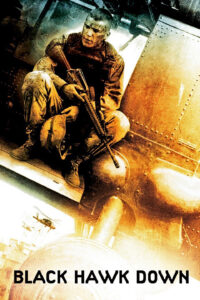 NOTE: Published in The Kansas City Kansan newspaper, January 18, 2002. At the screening a month earlier, several heroic veterans of the battle were in the audience. We critics got to meet them following the viewing. It was truly a privilege.
NOTE: Published in The Kansas City Kansan newspaper, January 18, 2002. At the screening a month earlier, several heroic veterans of the battle were in the audience. We critics got to meet them following the viewing. It was truly a privilege.
By Steve Crum
Based on the actual 1993 Battle of Somalia in Mogadishu, Black Hawk Down stars Pearl Harbor’s Josh Hartnett, as well as Ewan McGregor and Tom Sizemore. This is a movie that when your friends ask, “Who’s 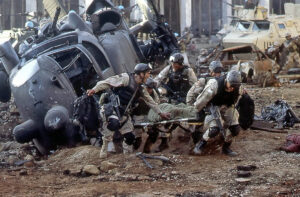 in it?”, you answer, “There are no big stars here, but this is a big movie.”
in it?”, you answer, “There are no big stars here, but this is a big movie.”
Superbly directed by Ridley Scott, the film serves as a historical document of tragedy that occurred when U. S. Forces were sent to the region to aid the United Nations in the distribution of food and supplies to literally starving Somalis. Over 300,000 had already starved to death due to local warlords hoarding the food to assume control of the city.
As one Black Hawk helicopter is shot down over the heart of the city—and soon followed by another, the Americans are drawn into an unplanned battle, virtually with the entire city.
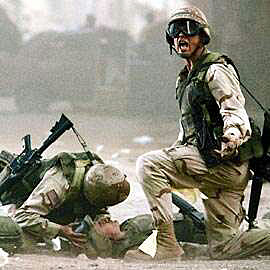 The storyline is segmented, focusing on many strings of happenings: a ranger falls from a copter, and is rescued under fire; a soldier has to reach barehanded into another’s insides to pinch off an artery—and there is no morphine available to cut the pain. A grunt is deafened when a buddy fires too close to his ear. A soldier picks up a fellow soldier’s severed hand, and dutifully stuffs it into his belt pack.
The storyline is segmented, focusing on many strings of happenings: a ranger falls from a copter, and is rescued under fire; a soldier has to reach barehanded into another’s insides to pinch off an artery—and there is no morphine available to cut the pain. A grunt is deafened when a buddy fires too close to his ear. A soldier picks up a fellow soldier’s severed hand, and dutifully stuffs it into his belt pack.
Ridley Scott’s excited camera juts to a rocket screaming toward two soldiers who crouch near a  doorway. And the air is full of battle pollution, looking like volcanic ash, looking like the air images of New York City and the Twin Towers hell.
doorway. And the air is full of battle pollution, looking like volcanic ash, looking like the air images of New York City and the Twin Towers hell.
All the while, the cool-under-fire strategists, safely back at base camp, relay straight-on orders through ground leaders’ high tech head sets.
Black Hawk Down jerks you around, slaps the side of your head, and kicks your butt back up to keep moving on. It is as close to interactive as any movie…ever.
GRADE on an A-F Scale: A
THE KANSAS CITY JOLSON STORY…Part 4: “THE WHIRL OF SOCIETY” and “A NIGHT WITH THE PIERROTS”
By Steve Crum
NOTE: The images and copied text are from both The Kansas City Times & The Kansas City Star, both newspapers owned by the same company.
∞∞∞∞∞
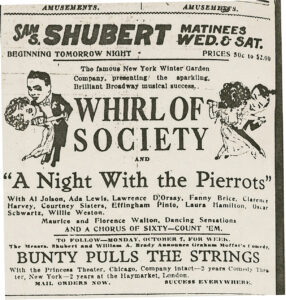 Broadway, exemplified by The Winter Garden Theater, was the perfect fit for Al Jolson. Billed as a featured performer from the start, Jolson would soon become headliner extraordinaire. Jolie, in blackface, portrayed Erastus Sparkler in “La Belle Paree” from March 20-June 10, 1911. The show then toured a few Eastern cities. He was Claude, a black waiter, in “Vera Violetta,” Nov. 3, 1911-Feb. 29, 1912 (includes another Eastern city tour).
Broadway, exemplified by The Winter Garden Theater, was the perfect fit for Al Jolson. Billed as a featured performer from the start, Jolson would soon become headliner extraordinaire. Jolie, in blackface, portrayed Erastus Sparkler in “La Belle Paree” from March 20-June 10, 1911. The show then toured a few Eastern cities. He was Claude, a black waiter, in “Vera Violetta,” Nov. 3, 1911-Feb. 29, 1912 (includes another Eastern city tour).
After a March 1-2, 1912 preview in Albany, “The Whirl of Society” and “A Night With the Pierrots” opened March 5 at the Winter Garden. It ran through June 19, followed by an interestingly plotted tour of mainly Eastern cities, along with a handful of Midwest sites and two dates in Canada: Montreal and Toronto.
The Sam S. Shubert Theater in Kansas City was stop two on the trek, following a month’s booking in Chicago. Jolson and company played KC, Sept. 29-Oct. 5, 1912. It was in “The Whirl of Society” that Jolson sang “Snap Your Fingers,” “Row, Row, Row,” and “Waiting for the Robert E. Lee.”
———-
The ads and engravings for the Kansas City production show Jolson, caricatured with dark eyes, bending back his partner. Then again, perhaps it is not Jolson since 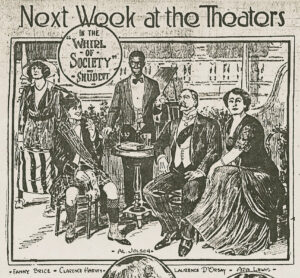 he is not “blacked up.” In another promo for the show that appears to be an engraving, Jolson is in blackface, playing his soon to be trademarked character Gus. Cast member Fanny Brice is pictured to Jolson’s right.
he is not “blacked up.” In another promo for the show that appears to be an engraving, Jolson is in blackface, playing his soon to be trademarked character Gus. Cast member Fanny Brice is pictured to Jolson’s right.
∞∞∞∞∞
Advance Story under etching:
Shubert~”Whirl of Society.”
One of the biggest attractions to play the Shubert Theater this season will be given there next week, when the New York Winter Garden Company presents “The Whirl of Society” and “A Night With the Pierrots.” The engagement will open tomorrow night. The company has just finished a long run at 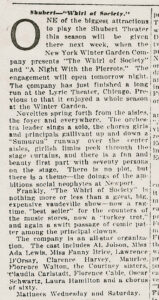 the Lyric Theater, Chicago. Previous to that it enjoyed a whole season at the Winter Garden.
the Lyric Theater, Chicago. Previous to that it enjoyed a whole season at the Winter Garden.
Novelties spring forth from the aisles, the foyer and everywhere. The orchestra leader sings a solo, the chorus girls and principals gallivant up and down a “Sumurun” runway over the center aisles, girlish limbs peek through the stage curtains, and there is a fun and beauty first part with seventy persons on the stage. There is no plot, but there is a theme–the doings of the ambitious social neophytes at Newport.
Frankly, “The Whirl of Society” is nothing more or less than a great, big, expensive vaudeville show–now a ragtime “best seller” for the counters of the music stores, now a “turkey trot,” and again a swift passage of comic patter among the principal clowns.
The company is an all-star organization. The cast includes Al. Jolson, Miss Ada Lewis, Miss Fanny Brice, Lawrence D’Orsay, Clarence Harvey, Maurice, Florence Walton, the Courtney Sisters, Claudia Carlstadt, Florence Cable, Oscar Schwartz, Laura Hamilton and a chorus of sixty.
Matinees Wednesday and Saturday.
_____
NEXT, Part 5 of The Kansas City Jolson Story: Jolson’s first extravaganza as star, “THE HONEYMOON EXPRESS.” [Please use Search for Honeymoon Express.]
THE KANSAS CITY JOLSON STORY…Part 3: Al Jolson’s Single Act in Vaudeville
 By Steve Crum
By Steve Crum
The following images were culled from both “The Kansas City Times” and “The Kansas City Star” from 1909-11. (Both newspapers were owned by the same company, with the “Times” being the morning edition and the “Star,” the evening.)
∞∞∞∞∞
More than a year after Jolson left  Dockstader on Dec. 18, 1909, he hit the UBO vaudeville circuit, beginning Dec. 27, 1910. His last date in vaudeville was Feb. 20-25, 1911 at Hammerstein’s Victoria in New York City. That location rings bells for “Jolson Story” fans since it is depicted in the film that Jolson nearly makes his breakthrough at Hammerstein’s. Instead, some time later, he opens at the Winter Garden, and maneuvers his way on stage to sing “My Mammy.”
Dockstader on Dec. 18, 1909, he hit the UBO vaudeville circuit, beginning Dec. 27, 1910. His last date in vaudeville was Feb. 20-25, 1911 at Hammerstein’s Victoria in New York City. That location rings bells for “Jolson Story” fans since it is depicted in the film that Jolson nearly makes his breakthrough at Hammerstein’s. Instead, some time later, he opens at the Winter Garden, and maneuvers his way on stage to sing “My Mammy.”
In actuality, before he was a sensation at the Winter Garden in “La Belle Paree” beginning March 20, 1911, Jolie was a single in Kansas City at the Orpheum, Dec. 4-10, 1910. Billed as “Al. Jolson, Late Star Dockstader’s Minstrels,” he gets billing just below the headlining Dinkle-Speil’s Christmas.
A note for the keen eye: The Dec. 5, 1910 display ad for Jolson’s single act (with Dinklespeil’s Christmas) includes a 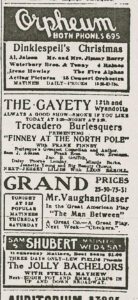 curiosity. Three ads below Jolson’s is a promo for Shubert’s “The Jolly Bachelors.” The star, Stella Mayhew, would four months later co-star with Jolson in Jolie’s first Shubert musical, “La Belle Paree.” She would continue performing with him in Jolson’s next two Shubert shows, “Vera Violetta” and “The Whirl of Society.”
curiosity. Three ads below Jolson’s is a promo for Shubert’s “The Jolly Bachelors.” The star, Stella Mayhew, would four months later co-star with Jolson in Jolie’s first Shubert musical, “La Belle Paree.” She would continue performing with him in Jolson’s next two Shubert shows, “Vera Violetta” and “The Whirl of Society.”
∞∞∞∞∞
A thought in perspective: Think about it. It has been over a century since these Jolson events occurred.
∞∞∞∞∞
Coming in Part 4: Jolson’s Broadway theater break in “The Whirl of Society.”
THE KANSAS CITY JOLSON STORY…Part 2: Jolie Joins Dockstader
By Steve Crum
NOTE: All illustrations are copied from The Kansas City Times & The Kansas City Star, and accompanied the preview stories and reviews.
 Al Jolson’s tenure with Lew Dockstader’s Minstrels began Aug. 10, 1908. A couple of months after the troupe began their national circuit tour, they stopped at Kansas City’s Grand Opera House, from Oct. 18-24. Notice the display ad touting its “$25,000 production.” The minstrels are listed as “Corkers.” I found it interesting that the long forgotten Neil O’Brien gets top billing over Jolson. (Notice Neil O’Brien’s image in the advance story at left.) Still, Jolson’s name is in larger typeface than the rest of the company. Interesting also is that the Oct. 17 advance advertisement is placed next to an ad for the “mighty” play, “Ben-Hur.”
Al Jolson’s tenure with Lew Dockstader’s Minstrels began Aug. 10, 1908. A couple of months after the troupe began their national circuit tour, they stopped at Kansas City’s Grand Opera House, from Oct. 18-24. Notice the display ad touting its “$25,000 production.” The minstrels are listed as “Corkers.” I found it interesting that the long forgotten Neil O’Brien gets top billing over Jolson. (Notice Neil O’Brien’s image in the advance story at left.) Still, Jolson’s name is in larger typeface than the rest of the company. Interesting also is that the Oct. 17 advance advertisement is placed next to an ad for the “mighty” play, “Ben-Hur.”
Here is how KC’s newspaper promoted it:
Lew Dockstader has something really new this season. The usual first part has been abandoned in favor of the Possum Hunt club. When the curtain rises the members of the club are in social session, which means jokes, singing and dancing. During the session the president of the club calls attention to the fact that the white man has failed to reach the North pole, and suggests that the colored race make the attempt. The motion is carried and Lew Dockstader is appointed chief explorer. This theme is carried through the entire entertainment and the finale of the show pictures the Arctic regions with the aurora borealis as a frame for Dockstader a la Roosevelt, triumphantly holding the North pole in one hand. A mammoth polar bear is in meek  submission at his feet, while the great
submission at his feet, while the great  iceberg on which the explorers ride rocks to and fro.
iceberg on which the explorers ride rocks to and fro.
In the list of comedians and end men with Dockstader this year are Neil O’Brien, who has a new absurdity entitled “The House of Rest,” Al Jolson, Eddie Mazier, Pete Detzel, John Daly and Tommy Hyde. The singing strength of the organization contains Will Oakland, W.H. Thompson, Herbert Willison, James Bradley, George M. Vail, Master Pierce Keegan and a choir of twenty. Dockstader’s individual offering is a portrayal of W.H. Taft, who goes campaigning in a submarine boat. Dockstader shares in “Boo Hoo Land,” also a spectacular number in which Dockstader and a companion fall from an airship and land among cannibals on an island in some far away sea.
∞∞∞∞∞
A year later, May 22 & 23, 1909, Dockstader’s Minstrels returned to KC with their 70 minstrels. Love that ad wherein a Boston Herald critic states: “WHEN YOU GO TO HEAR LEW DOCKSTADER’S MINSTRELS, DON’T WEAR TIGHT CLOTHES.” The show must have had some seam-busting laughs. According to an advance blurb, Al Jolson leads the performers in “a new absurdity entitled, ‘The House of Rest.’”
The Kansas City Times preview story:
Lew Dockstader and his minstrels will be the last attraction at the Grand Opera house this season. Dockstader was at the 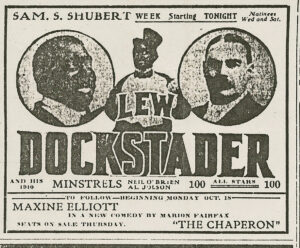 Grand last October, and the warmth of the public’s welcome then is the inducement for return so soon. Those who saw the Dockstader show last fall know how much fun it contained; those who did not see it then may be interested in knowing that the company number seventy people, including Neil O’Brien, Al Jolson, Eddie Mazier, Pete Detzel, John Daly, Tommy Hyde and a corps of twenty singers, among whom are W. H. Thompson, George M. Vail, Herbert Willison, Wilson Miller, James Bradley and Master Pierce Keegan, with Will H. Hallett as interlocutor.
Grand last October, and the warmth of the public’s welcome then is the inducement for return so soon. Those who saw the Dockstader show last fall know how much fun it contained; those who did not see it then may be interested in knowing that the company number seventy people, including Neil O’Brien, Al Jolson, Eddie Mazier, Pete Detzel, John Daly, Tommy Hyde and a corps of twenty singers, among whom are W. H. Thompson, George M. Vail, Herbert Willison, Wilson Miller, James Bradley and Master Pierce Keegan, with Will H. Hallett as interlocutor.
The introductory part presents the Possum Hunt club, a colored organization. in social session, during which the club decides to send Dockstader at the head of an  exploring expedition to accomplish what the white man has failed in, namely, the discovery of the North Pole. and this theme is carried throughout the performance.
exploring expedition to accomplish what the white man has failed in, namely, the discovery of the North Pole. and this theme is carried throughout the performance.
Neil O’Brien presents a new sketch called “The House of Rest,” said to be even funnier than his street car act of the past. Dockstader has added William H. Taft to his list of famous caricatures of great men. The finale of the evening show Dockstader, made up a la Roosevelt, captor of the North Pole, which he has under his arm, and leading a great Polar bear.
∞∞∞∞∞
A few months later, the Dockstader Minstrels returned to KC. It was during the week of Oct. 11, 1909 when this brief preview blurb ran in the local newspaper:
Lew Dockstader has turned aviator and is using an aeroplane for his chief specialty this season. Al Jolson and Neil O’Brien also have new stunts, all of which will be shown at the Shubert this week, beginning tonight. The change from the Grand Opera House to the Shubert is due to the fact that Dockstader now is under the booking agency of the Shubert independents. The Dockstader show is said to be the largest and most expensive the minstrel man has ever had.
A separate blurb:
At the theaters this week is a diversified line of attractions ranging from minstrelsy to extravaganza. Lew Dockstader is at the Shubert Theater with his black face company, which includes Al Jolson, Eddie Mazier, Neil O’Brien and Peter Detzel in a new feature–a frolic of the Aero Possum Club. There are many good songs.
SEE Part III of THE KANSAS CITY JOLSON STORY, covering Al Jolson’s transition to a Single Vaudeville Act. You ain’t read nothin’ yet!
Get your dinosaur fix with ‘Jurassic World Dominion’—the perfect summer movie
 By Steve Crum
By Steve Crum
If Jurassic World Dominion doesn’t tease your Pterodactyl…doesn’t bend your Brontosaurus…doesn’t rattle your Raptor, you have no business calling yourself a dinosaur movie fanatic. That established, I AM a dinosaur movie fanatic. Here is a nearly non-stop, sci-fi action flick that is on prehistoric overload.
Think of it as a glorious 146-minutes packed with every creature that has ever appeared in the previous five films of the Jurassic franchise…plus a few new creepies. (Say hello to destructive locusts the size of small dogs.)
Be assured that JWD is in good hands. This is Colin Trevorrow’s third Jurassic World film as director, 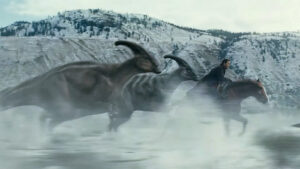 as well as his third time writing the screenplay. Dominion is the sequel to Jurassic World Fallen Kingdom (2018), set four years later. Now the myriad number of creatures are no longer confined to a remote island or theme park. (Isla Nublar has been destroyed.) The creatures reside worldwide, living with humans as pets and even cattle—not unlike steers.
as well as his third time writing the screenplay. Dominion is the sequel to Jurassic World Fallen Kingdom (2018), set four years later. Now the myriad number of creatures are no longer confined to a remote island or theme park. (Isla Nublar has been destroyed.) The creatures reside worldwide, living with humans as pets and even cattle—not unlike steers.
However, all is not ideal. For example, the film includes a sad scene, set in Malta, in which dinosaurs are sold and forced into combat with other dinosaurs, a la cockfighting.
Segue to the opening sequence wherein Owen Grady (Chris Pratt) is shown at his remote ranch on horseback, ridin’ & ropin’ with a herd of Parsaurolophus. It is now part of accepted ranch life. There are also subplot surprises involving Grady’s favorite Velociraptor—who happens to live in the woods nearby.
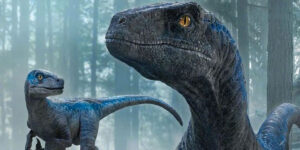 In fact, there are so many primary characters featured that screen scribes Trevorrow and Emily Carmichael had to divide the colorful tale into two concurrent plots, allowing the viewer to get dizzyingly involved. It is a fun ride.
In fact, there are so many primary characters featured that screen scribes Trevorrow and Emily Carmichael had to divide the colorful tale into two concurrent plots, allowing the viewer to get dizzyingly involved. It is a fun ride.
Add those aforementioned characters with three from the first Jurassic Park trilogy: Dr. Ellie Sattler (Laura Dern), Dr. Ian Malcolm (Jeff Goldblum), and Dr. Alan Grant (Sam Neill). All are 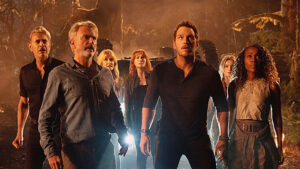 well played. The latter unites to solve the impending worldwide food shortage brought on by an evil, money grubbing Biosyn CEO billionaire, Dr. Lewis Dodgson (Campbell Scott).
well played. The latter unites to solve the impending worldwide food shortage brought on by an evil, money grubbing Biosyn CEO billionaire, Dr. Lewis Dodgson (Campbell Scott).
Dodgson is also behind the kidnapping of teen Maisie Lockwood (Isabella Sermon), who is the adoptive daughter of Grady and his girlfriend Clair Dearing (Bryce Dallas Howard).
Along the way are helpful encounters with a couple of good folks: DeWanda Wise’s Kayla Watts, a rough and tumble former Air Force pilot…and Mamoudou Athie’s Ramsay Cole, Biosyn’s Head of Communications.
The Jurassic World music is once again handled well by composer Michael Giacchino—with John Williams’ original Jurassic Park theme weaved in.
It has been rumored that Jurassic World Dominion is the grand finale of all the Jurassic movies. The fact is Dominion is Part 3 of the World 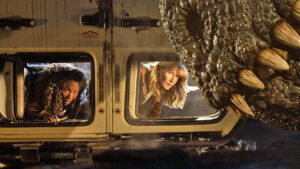 trilogy. But is it the very last film? Is there another trilogy in the plans? Stay, as they say, tuned.
trilogy. But is it the very last film? Is there another trilogy in the plans? Stay, as they say, tuned.
∞∞∞∞∞
Just a personal addendum: My favorite dinosaur, Dilophosarus, shows up a couple of times in JWD. That curious, homicidal guy/gal, last seen in the very first Jurassic Park film, is the one who spits blinding, tar-looking venom into one’s eyes. How quaint.
∞∞∞∞∞
GRADE on an A-F Scale: A
